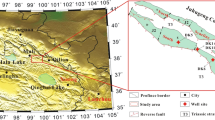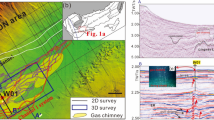Abstract
The Muli area has dense lithology, high hardness, poor porosity and permeability, and well-developed micro-fractures, which is different from other gas hydrate regions with unconsolidated sediment characteristics. With the gradual deepening of gas hydrate scientific research in the Muli area, some unique low-resistivity gas hydrate phenomena have been discovered. The understanding of the genesis mechanism of low-resistivity gas hydrate is not clear, which makes it difficult to identify gas hydrate layers and adversely affects the evaluation of reservoir parameters and reserves prediction. In this investigation, the well logging response law of pore-filling and fracture-filling gas hydrate reservoirs is systematically combined and the associated reservoir characteristics relationships are evaluated as a function of lithology, physical properties, reservoir space, gas hydrate and fluid distribution characteristics. Then, the correlation between cementation index and pore structure complexity index was fitted. Finally, a new gas hydrate saturation calculation model is proposed. The results show that the new saturation calculation model is in good agreement with the well logging interpretation of gas hydrate, which can identify low-resistivity gas hydrate effectively. The results of this study thus assist in terms of reliable gas hydrate exploration in the Muli area.

















Similar content being viewed by others
References
Cao, Y., Jiang, Z., Xia, B., Yang, W., & Zhang, J. (2003). Method, principle and example of identifying sequence stratigraphical boundary using sonic logging. Acta Sedimentologica Sinica, 21(2), 318–323.
Collett, T. S., Lee, M. W., Zyrianova, M. V., Mrozewski, S. A., Guerin, G., Cook, A. E., & Goldberg, D. S. (2012). Gulf of Mexico Gas Hydrate Joint Industry Project Leg II logging-while-drilling data acquisition and analysis. Marine and Petroleum Geology, 34(1), 41–61.
Collett, T. S., Lewis, R. E., Winters, W. J., Lee, M. W., Rose, K. K., & Boswell, R. M. (2011). Downhole well log and core montages from the Mount Elbert gas hydrate stratigraphic test well, Alaska North Slope. Marine and Petroleum Geology, 28(2), 561–577.
Daigle, H., Cook, A., & Malinverno, A. (2015). Permeability and porosity of hydrate-bearing sediments in the northern Gulf of Mexico. Marine and Petroleum Geology, 68, 551–564.
Dong, H., Sun, J., Arif, M., Golsanami, N., Yan, W., & Zhang, Y. (2020). A novel hybrid method for gas hydrate filling modes identification via digital rock. Marine and Petroleum Geology, 115, 104255.
Dong, H., Sun, J., Cui, L., Golsanami, N., & Yan, W. (2019a). Characteristics of the pore structure of natural gas hydrate reservoir in the Qilian Mountain Permafrost, Northwest China. Journal of Applied Geophysics, 164, 153–159.
Dong, H., Sun, J., Lin, Z., Cui, L., & Yan, W. (2018). Quantitative characterization and characteristics analysis of microscopic pore structure in natural gas hydrate based on CT scanning. Journal of China University of Petroleum, 42(6), 40–49.
Dong, H., Sun, J., Zhu, J., Liu, L., Lin, Z., Golsanami, N., Cui, L., & Yan, W. (2019b). Developing a new hydrate saturation calculation model for hydrate-bearing sediments. Fuel, 248, 27–37.
Fan, D., Lu, Z., Xiao, R., Niu, S., Qi, L., Wei, Y., Zhang, Y., Fei, D., & Dang, X. (2018). Geological characteristics of Carboniferous-Jurassic potential source rocks for natural gas hydrates in Muli depression, South Qilian Basin. Geoscience, 32(5), 985–994.
Fang, H., Xu, M., Lin, Z., Zhong, Q., Bai, D., Liu, J., Pei, F., & He, M. (2017). Geophysical characteristics of gas hydrate in the Muli area, Qinghai province. Journal of Natural Gas Science and Engineering, 37, 539–550.
Han, X., Li, L., Yang, L., Zhao, H., Cheng, D., & Qiu, J. (2012). Petrophysical experimental research in Tanan tuffaceous pyroclastic rock reservoir. Journal of China University of Petroleum, 36(3), 69–75.
Lee, M. W., & Collett, T. S. (2012). Pore-and fracture-filling gas hydrate reservoirs in the Gulf of Mexico gas hydrate joint industry project leg II Green Canyon 955 H well. Marine and Petroleum Geology, 34(1), 62–71.
Lee, M. W., & Waite, W. F. (2008). Estimating pore-space gas hydrate saturations from well log acoustic data. Geochemistry, Geophysics, Geosystems, 9(7), Q07008.
Li, B., Sun, Y., Guo, W., Shan, X., Wang, P., Pang, S., Jia, R., & Zhang, G. (2017). The mechanism and verification analysis of permafrost-associated gas hydrate formation in the Qilian Mountain, Northwest China. Marine and Petroleum Geology, 86, 787–797.
Lin, Z., Liu, D., Pan, H., Li, Y., Gao, W., Qiu, L., & Zhang, X. (2017). Response characteristics of gas hydrate well-logging in Muli area. Geophysical and Geochemical Exploration, 41(6), 1012–1018.
Lin, Z., Pan, H., Fang, H., Gao, W., & Liu, D. (2018). High-altitude well log evaluation of a permafrost gas hydrate reservoir in the Muli area of Qinghai, China. Scientific Reports, 8, 12596.
Lu, J., Tang, H., & Sun, Y. (2019). Measures and suggestions on restraining China’s excessive growth of natural gas external dependence. Natural Gas Industry, 39(8), 1–9.
Lu, Z., Zhai, G., Zhu, Y., Zhang, Y., Li, Y., Wang, W., Wang, T., Liu, H., Tang, S., & Tan, P. (2016). Fault control of gas hydrate accumulation in Qilian Mountain permafrost. International Journal of Offshore and Polar Engineering, 26(2), 199–205.
Luo, M., Wang, H., Yang, S., & Chen, D. (2013). Research advancement of natural gas hydrate in South China Sea. Bulletin of Mineralogy, Petrology and Geochemistry, 32(1), 56–69.
Mao, Z., & Gao, C. (2000). Theoretical simulation of the resistivity and pore structure of hydrocarbon bearing rocks. Petroleum Exploration and Development, 27(2), 87–90.
Peng, C., Zou, C., Lu, Z., Yu, C., Liu, A., Tang, Y., Hu, X., Zhang, S., Wen, H., Li, Y., & Wang, W. (2018). Characteristics of gas hydrate reservoirs and their effect on petrophysical properties in the Muli area, Qinghai-Tibetan plateau permafrost. Journal of Natural Gas Science and Engineering, 57, 266–283.
Peng, C., Zou, C., Lu, Z., Yu, C., Liu, A., Tang, Y., Hu, X., Zhang, S., Wen, H., Li, Y., & Wang, W. (2019). Evidence of pore- and fracture-filling gas hydrates from geophysical logs in consolidated rocks of the Muli area, Qinghai-Tibetan plateau permafrost, China. Journal of Geophysical Research: Solid Earth, 124(7), 6297–6314.
Pi, G., Wang, M., Guang, X., & Dong, X. (2018). The status, challenges and countermeasures of natural gas hydrate exploration and development industry in China. China Mining Magazine, 27(4), 1–5.
Qu, L., Zou, C., Lu, Z., Yu, C., Li, N., Zhu, J., Zhang, X., Yue, X., & Gao, M. (2017). Elastic-wave velocity characterization of gas hydrate-bearing fractured reservoirs in a permafrost area of the Qilian Mountain, Northwest China. Marine and Petroleum Geology, 88, 1047–1058.
Song, Y., Jiang, Y., Song, Y., & Zhang, Y. (2014). Experimental on the influencing factors of m and n of low resistivity oil reservoirs in Southern Gulong area. Journal of Jilin University, 2, 704–714.
Wang, J. (2006). A summary of sonic logging techniques. Chinese Journal of Engineering Geophysics, 3(5), 395–400.
Wang, L., Yuan, W., Ding, L., & Luo, Y. (2018). Reservoir fluid identification based on normal logging data. Geological Science and Technology Information, 37(2), 241–245.
Wang, P., Zhu, Y., Lu, Z., Guo, X., & Huang, X. (2011). Gas hydrate in the Qilian Mountain permafrost and its distribution characteristics. Geological Bulletin of China, 30(12), 1839–1850.
Wang, X., Tan, F., Lv, J., Chen, Y., Zhang, J., & Leng, R. (2017). Log interpretation method of shale content for conglomerate reservoir, No. 1 area of east 7th block in Karamay oilfield. Well Logging Technology, 41(1), 64–70.
Wei, W., Zhang, J., Yu, R., Lin, B., Chen, L., Peng, Y., & Xiao, H. (2018). Review on natural gas hydrate in 2017. Science and Technology Review, 36(1), 83–90.
Wu, N., Zhang, G., Liang, J., Su, Z., Wu, D., Lu, H., Lu, J., Sha, Z., & Fu, S. (2013). Progress of gas hydrate research in Northern South China Sea. Advances in New and Renewable Energy, 1(1), 80–94.
Wu, S., & Wang, J. (2018). On the China’s successful gas production test from marine gas hydrate reservoirs. Chinese Science Bulletin, 63(1), 2–8.
Xiong, S. (2021). Research achievements of the Qinghai-Tibet Plateau based on 60 years of aeromagnetic surveys. China Geology, 4(1), 147–177.
Xu, M., Liu, J., Chai, M., Wang, G., Gao, J., Wang, X., & Zhang, B. (2011). Seismic characteristics of natural gas hydrate in Muli area, Tianjun County, Qinghai Province. Geological Bulletin of China, 30(12), 1910–1917.
Yang, J., & Liu, X. (2019). Review of natural gas development in 2018 and its outlook in 2019. Energy of China, 41(2), 16–21.
Yu, H., Wang, Z., Rezaee, R., Zhang, Y., Han, T., Arif, M., & Johnson, L. (2018). Porosity estimation in kerogen-bearing shale gas reservoirs. Journal of Natural Gas Science and Engineering, 52, 575–581.
Yun, M., Gao, J., He, Y., & Zhang, G. (2004). Relations of velocity and density with porosity, clay content and water saturation in reservoirs. Progress in Exploration Geophysics, 27(2), 104–107.
Zhang, J., Wei, W., Wei, X., Peng, Y., Wang, P., & Zhang, Q. (2014). Exploration and research progress of natural gas hydrate in China. Unconventional Oil and Gas, 1(1), 75–81.
Zhang, S. (2008). New research advancement on offshore exploration for natural gas hydrates in China. Natural Gas Industry, 28(1), 154–158.
Zhao, W., Li, H., & Yang, W. (2012). Status and evolution of geophysical exploration technology for unconventional oil and gas in China. China Petroleum Exploration, 17(4), 36–40.
Zhu, Y., Zhang, Y., Wen, H., Lu, Z., Jia, Z., Li, Y., Li, Q., Liu, C., Wang, P., & Guo, X. (2009). Gas hydrates in the Qilian mountain permafrost, Qinghai, Northwest China. Acta Geologica Sinica, 83(11), 1761–1770.
Zou, C., Tao, S., Yang, Z., Yuan, X., Zhu, R., Hou, L., Jia, J., Wang, L., Wu, S., Bai, B., Gao, X., & Yang, C. (2012). New advance in unconventional petroleum exploration and research in China. Bulletin of Mineralogy, Petrology and Geochemistry, 31(4), 312–322.
Zou, C., Yang, Z., Zhu, R., Zhang, G., Hou, L., Wu, S., Tao, S., Yuan, X., Dong, D., Wang, Y., Wang, L., Huang, J., & Wang, S. (2015). Progress in China’s unconventional oil & gas exploration and development and theoretical technologies. Acta Geologica Sinica, 6, 979–1007.
Funding
This work was supported by the National Natural Science Foundation of China (grant number 41874138) and China Postdoctoral Science Foundation Funded Project (grant number 2021M700525).
Author information
Authors and Affiliations
Contributions
The authors’ detailed responsibilities are as follows: HD: methodology, writing-original draft preparation, funding acquisition; JS: conceptualization, supervision, funding acquisition; MA: writing-reviewing and editing; XL: writing-review, data curation; NG: writing-reviewing and editing; WY: methodology, data processing; LC: investigation, validation; YZ: supervision, writing-reviewing and editing.
Corresponding author
Ethics declarations
Conflict of interest
The authors declare no competing financial interests.
Additional information
Publisher's Note
Springer Nature remains neutral with regard to jurisdictional claims in published maps and institutional affiliations.
Rights and permissions
Springer Nature or its licensor holds exclusive rights to this article under a publishing agreement with the author(s) or other rightsholder(s); author self-archiving of the accepted manuscript version of this article is solely governed by the terms of such publishing agreement and applicable law.
About this article
Cite this article
Dong, H., Sun, J., Arif, M. et al. A Method for Well Logging Identification and Evaluation of Low-Resistivity Gas Hydrate Layers. Pure Appl. Geophys. 179, 3357–3376 (2022). https://doi.org/10.1007/s00024-022-03120-x
Received:
Revised:
Accepted:
Published:
Issue Date:
DOI: https://doi.org/10.1007/s00024-022-03120-x




